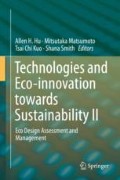Abstract
Various low-carbon products, such as photovoltaic (PV) panels, have been diffused to reduce CO2 emissions across the world. When we consider future uncertainties and product lifetimes, the question arises of how such products will reduce regional CO2 emissions over a longer period of time (e.g., 30 years). With the aim to answer this question, we describe scenarios to analyze the relationship among various social changes in the future (e.g., energy policy), the amount of low-carbon products diffused in a region, and the resulting CO2 emissions throughout the life cycle of the products. In this paper, we develop an integrated model for estimating the diffusion of low-carbon products and the CO2 emissions due to product diffusion using life cycle simulation. In a case study, we described several PV diffusion scenarios toward 2045 for the Tokyo area, in which we evaluated PV installation capacity and the CO2 emissions caused by PV diffusion. The results showed that the ownership rate of PV in 2045 would account for 36.8–53.6% of households. In addition, it was revealed that the extension of product lifetime provides the opportunity to reuse secondhand PV, causing less CO2 emissions than other scenarios.
Access this chapter
Tax calculation will be finalised at checkout
Purchases are for personal use only
References
Energy Information Administration (EIA). Model documentation report: residential sector demand module of the national energy modeling system. U.S. Department of Energy; 2013.
Cole W, Lewis H, Sigrin B, Margolis R. Interactions of rooftop PV deployment with the capacity expansion of the bulk power system. Appl Energy. 2016;168:473–81.
Wender BA, Foley RW, Prado-Lopez V, Ravikumar D, Eisenberg DA, Hottle TA, Sadowski J, Flanagan WP, Fisher A, Laurin L, Bates ME, Linkov I, Seager TP, Fraser MP, Guston DH. Illustrating anticipatory life cycle assessment for emerging photovoltaic technology. Environ Sci Technol. 2014;48:10531–8.
Ellen MacArthur Foundation. Towards the circular economy: economic and business rationale for an accelerated transition. England: Ellen MacArthur Foundation; 2012.
New Energy and Industrial Technology Development (NEDO). NEDO PV Challenges; 2014.
Kishita Y, Umeda Y. Development of Japan’s photovoltaic deployment scenarios in 2030. Int J Autom Technol. 2017;11:583–91.
Elshkaki A, Graedel TE. Dynamic analysis of the global metals flows and stocks in electricity generation technologies. J Clean Prod. 2013;59:260–73.
Peeters JR, Altamirano D, Dewulf W, Duflou JR. Forecasting the composition of emerging waste streams with sensitivity analysis: a case study for photovoltaic (PV) panels in Flanders. Resour Conserv Recycl. 2017;120:14–26.
Umeda Y, Nonomura A, Tomiyama T. Study on life-cycle design for the post mass production paradigm. Artificial Intelligence for engineering design, analysis and manufacturing. 2000;14:149–61.
Bass FM. A new product growth model for consumer durables. Manag Sci. 1969;15:215–27.
Matsumoto M, Kondoh S, Fujimoto J, Masui K. A modeling framework for the diffusion of green technologies. In: Sherif MH, Khalil TM, editors. Management of technology innovation and value creation: selected papers from the 16th international conference on Management of Technology. Singapore: World Scientific Publishing Company; 2008. p. 121–36.
The International Renewable Energy Agency (IRENA). End-of-life management solar photovoltaic panels. 2016.
Mizuho Information & Research Institute. Life Cycle Assessment of Photovoltaic Generation System. 2012. https://www.mizuho-ir.co.jp/publication/contribution/2012/oyobuturi1108_01.html.
Acknowledgments
This work was supported by the Environment Research and Technology Development Fund (S-16) of the Environmental Restoration and Conservation Agency and the Grant-in-Aid for Young Scientists (A) (No. 26701015) and Challenging Exploratory Research (No. 15 K12290) from the Japan Society for the Promotion of Science.
Author information
Authors and Affiliations
Corresponding author
Editor information
Editors and Affiliations
Rights and permissions
Copyright information
© 2019 Springer Nature Singapore Pte Ltd.
About this chapter
Cite this chapter
Saiki, K., Kishita, Y., Umeda, Y. (2019). Describing Diffusion Scenarios for Low-Carbon Products Using Life Cycle Simulation. In: Hu, A., Matsumoto, M., Kuo, T., Smith, S. (eds) Technologies and Eco-innovation towards Sustainability II. Springer, Singapore. https://doi.org/10.1007/978-981-13-1196-3_27
Download citation
DOI: https://doi.org/10.1007/978-981-13-1196-3_27
Published:
Publisher Name: Springer, Singapore
Print ISBN: 978-981-13-1195-6
Online ISBN: 978-981-13-1196-3
eBook Packages: Earth and Environmental ScienceEarth and Environmental Science (R0)

